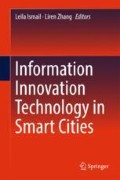Abstract
The migration to smart cities will provide citizens with a plethora of services under the umbrella of Internet of Things, such as real time health monitoring, smart vehicular, and road control systems. To meet smart cities’ needs, technological development in the fields of Smart Grid, Big Data processing and Broadband Communication, has started. In particular, the development in the domain of broadband communication must take into account data rate maximization and latency minimization, while keeping eyes on the environmental friendly aspect. One promising concept in this context is the heavy deployment of 4G and beyond networks where energy efficiency is a major focal point. Hence, the focus of this chapter is targeted towards green multicell networks, where dense frequency reutilization is used in smart cities. The ensuing Inter-Cell Interference (ICI) harms radio transmissions and degrades their performances. Thus, a certain degree of ICI Coordination (ICIC) between serving evolved Node B (eNBs) is required to manage the resources and minimize the interference level.
References
Auer G, Blume O, Giannini V, Godor I, Imran M, Jading Y, Katranaras E, Olsson M, Sabella D, Skillermark P et al (2010) D2. 3: Energy efficiency analysis of the reference systems, areas of improvements and target breakdown, INFSOICT-247733. EARTH (Energy Aware Radio and NeTwork TecHnologies), Tech. Rep.
Huang J, Berry RA, Hoing ML (2006) Distributed interference compensation for wireless networks. IEEE J Sel Areas Commun 24(5):1074–1084
Rosen JB (1965) Existence and uniqueness of equilibrium points for concave n-person games. Econometrica 33
Topkis (1979) Equilibrium points in non-zero sum n-person sub-modular games. SIAM J Control Optim 17(6):773–787
GPP TR 36.942 V12.0.0 Release 12. Evolved Universal Terrestrial Radio Access; (E-UTRA); Radio Frequency (RF) system scenarios, October 2014
Author information
Authors and Affiliations
Corresponding author
Editor information
Editors and Affiliations
Rights and permissions
Copyright information
© 2018 Springer Nature Singapore Pte Ltd.
About this chapter
Cite this chapter
Maaz, B., Khawam, K., Lahoud, S., Nasreddine, J., Tohme, S. (2018). Achieving Spectral and Energy Efficiencies in Smart Cities Multi-cell Networks. In: Ismail, L., Zhang, L. (eds) Information Innovation Technology in Smart Cities. Springer, Singapore. https://doi.org/10.1007/978-981-10-1741-4_19
Download citation
DOI: https://doi.org/10.1007/978-981-10-1741-4_19
Published:
Publisher Name: Springer, Singapore
Print ISBN: 978-981-10-1740-7
Online ISBN: 978-981-10-1741-4
eBook Packages: EngineeringEngineering (R0)

